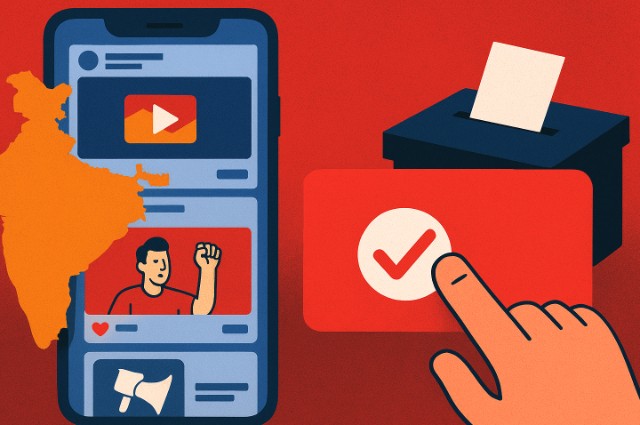
With the rise of digital India, internet penetration has made communication faster, wider, and cheaper. But in that very process, something deeper is shifting. The news no longer breaks on TV at 9 PM; it breaks on TikTok, Instagram, and YouTube in 9 seconds.
These platforms aren’t just feeding entertainment anymore; they’re shaping politics. Social media is slowly, and sometimes aggressively, becoming the new Parliament floor, the new newsroom, and in many ways, the new voter base battlefield. And here’s the thing: 73% of Indian social media users are between 18 and 30. That’s not a random demographic stat; that’s a power base. And when that base is influenced more by reels and trending sounds than reported facts, it changes how democracy plays out. Not just in India, but everywhere.
From Entertainment to Electoral Influence
It started harmlessly. Instagram was for photos, TikTok was for dance videos, and YouTube was for creators. But slowly, these platforms became the prime space where people talk politics, form opinions, and even decide who they’ll vote for. The transition from entertainment to political influence wasn’t accidental; it was algorithmic. Short videos, emotional hooks, controversial takes, and viral content aren’t just keeping people engaged; they’re locking them in. And political parties know this. No one wants to read a 2,000-word editorial anymore. They want a 20-second summary, preferably with music and subtitles. They don’t want to sit through a debate—they want a snappy reel that confirms what they already believe. This isn’t just about shortening attention spans; it’s about changing the very architecture of influence.
News, Now Filtered by You
Traditional media TV news, newspapers, and verified journals, are losing their grip. It’s not just about declining trust. It’s about replacing trust. People, especially Gen Z and young millennials, are now getting their “news” from Instagram pages with aesthetically pleasing posts, or from influencers who post daily “hot takes” while sipping coffee. These sources are unaccountable, unverified, and often biased, but they’re relatable. That relatability is killing credibility. Journalists used to be gatekeepers of information. Now the gates are wide open, and there’s a flood of unverified, emotionally charged content pouring through. Sometimes it looks like democracy in action. But if the information you’re basing your vote on is flawed, biased, or fake—what kind of democracy is that?
The Algorithm Doesn’t Care About Truth
The algorithms behind TikTok and Instagram are not built to prioritize the truth. They’re built to prioritize engagement. That means more drama, more outrage, more virality. The more you react, the more it feeds you similar content.
Now, you don’t see what’s real—you see what you want to see. That’s not just dangerous. It’s a threat to the foundation of how public opinion is formed in a democracy.
A 19-year-old with no political education can comment on a complicated policy just because a reel said “this is injustice.” That same person may never bother to verify it. Why would they? The next dopamine hit is just a scroll away.
The Emotional Hook of Politics 2.0
Political parties are fully aware of this shift. They’re not just spending on rallies and newspaper ads anymore. According to data from Lokniti, the BJP, Congress, and Aam Aadmi Party have all significantly ramped up their spending on social media campaigns. Memes, songs, comedy sketches, aesthetic quote-posts, all of it is now part of mainstream political messaging. The aim isn’t just to inform. It’s to emotionally lock you in. This means politics is no longer about reasoned discourse. It’s about who can make you feel the most—angry, proud, scared, patriotic, betrayed. The more you feel, the more you engage. And the more you engage, the more likely you are to vote how they want you to.
From Information to Influence to Control
What makes this shift dangerous is not just the content, but the control. These platforms are shaping public consciousness at scale. And nobody is fully regulating them. The line between influence and manipulation is thin—and social media is blurring it even more. Earlier, editors and media watchdogs had the power to stop misinformation or at least call it out. Today, a fake news reel can go viral, cross a million views, and change minds before anyone even checks it. By the time a fact-checker posts a rebuttal, it’s too late. The emotional damage is done.
So, What Now?
This isn’t a call to abandon social media. It’s a wake-up call to see it for what it is: not just entertainment, but political machinery. If you scroll blindly, you’re being shaped. Not informed shaped. If the platforms you trust for information don’t prioritize truth, and if the content you consume is designed only to trigger and entertain, then forming real, thoughtful opinions becomes harder. And in a democracy, that’s not just sad, it’s dangerous. Social media can be a tool for democratizing voices—but only if users know how to think beyond the feed.
Because the next time you swipe up, ask yourself:
Is this content informing me, or is it programming me?
